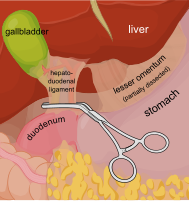
Photo from wikipedia
Background The Pringle maneuver is often used in liver surgery to minimize bleeding during liver transection. Many authors have demonstrated that intermittent use of the Pringle maneuver is safe and… Click to show full abstract
Background The Pringle maneuver is often used in liver surgery to minimize bleeding during liver transection. Many authors have demonstrated that intermittent use of the Pringle maneuver is safe and effective when performed appropriately. However, some studies have reported that the Pringle maneuver is a significant risk factor for portal vein thrombosis. In this study, we evaluated the effectiveness of portal vein flow after the Pringle maneuver and the impact that massaging the hepatoduodenal ligament after the Pringle maneuver has on portal vein flow. Materials and Methods Patients treated with the Pringle maneuver for hepatectomies performed to treat hepatic disease at our hospital between August 2014 and March 2019 were included in the study ( N = 101). We divided these patients into two groups, a massage group and nonmassage group. We measured portal vein blood flow with ultrasonography before and after clamping of the hepatoduodenal ligament. We also evaluated laboratory data after the hepatectomy. Results Portal vein flow was significantly lower after the Pringle maneuver than before clamping of the hepatoduodenal ligament. The portal vein flow after the Pringle maneuver was improved following massage of the hepatoduodenal ligament. After hepatectomy, serum prothrombin time was significantly higher and serum C-reactive protein was significantly lower in the massage group than in the nonmassage group. Conclusion Massaging the hepatoduodenal ligament after the Pringle maneuver is recommended in order to quickly recover portal vein flow during hepatectomy and to improve coagulability.
Journal Title: World Journal of Surgery
Year Published: 2020
Link to full text (if available)
Share on Social Media: Sign Up to like & get
recommendations!